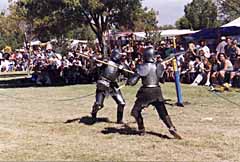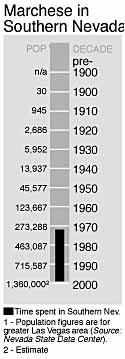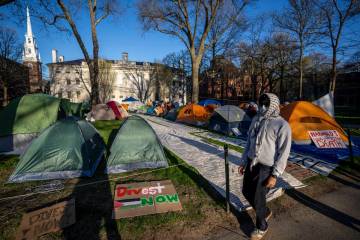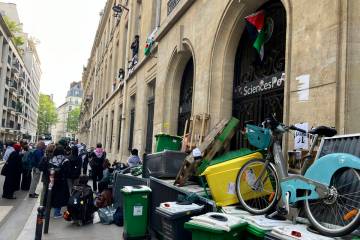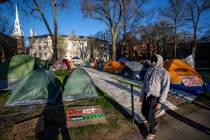Patricia Marchese
Patricia Marchese hadn't been in Las Vegas too long when she saw a local guy blowing a trumpet at some informal concert. The Angel Gabriel couldn't have done better, she thought.
"That guy's probably got a future," she commented to a bystander.
"I guess he might," came the response. "He's already lead trumpet for `Blood, Sweat & Tears.' "
Marchese quickly saw the resources Las Vegas show-business culture offered. She tapped into them to organize most of the city of Las Vegas' present cultural affairs program, then did it all over again for Clark County.
The two programs became the core of the Las Vegas cultural scene, training and employing artists and technicians who branched out into privately funded efforts. Now she's assistant director of the Clark County Parks and Recreation Department, supervising not only cultural affairs but also museums, recreation, sports, aquatics, special facilities and park maintenance.
Marchese once made her living with, and won some awards for, her silk-screened prints. In 1972 she moved to Las Vegas with her husband, Lamar, who had taken a job with the Clark County Library District. The following year, she answered an ad seeking a person to start a cultural affairs program, and got the job.
"I was in the right place at the right time," she said. She didn't have to talk the Las Vegas City Council into supporting the arts. "It was their idea. ... There was some impetus from the community."
The city also happened to have an appropriate facility available for a cultural arts center. Las Vegas had purchased an outdated Mormon facility to use as a temporary headquarters while its old City Hall was torn down and a new one built. With city government moved into its new home, the temporary one was available. The city designated it for recreation and cultural affairs, and named it Reed Whipple Center, for a city commissioner and church official who brokered the deal.
The building came equipped with a small stage, so that was one of the first resources Marchese utilized. She hired Jody Johnston, who was the daughter of entertainer Totie Fields, and a young local playwright named Brian Strom to build Rainbow Company, a children's theater. Johnston called it "an incredibly farsighted move" in a 1982 interview, pointing out "It's rare that a municipality seeks out the arts."
The new troupe rewarded that foresight by winning recognition from the Children's Theater Association of America as best in the United States -- and has since won that designation repeatedly. Strom became a respected local director; Rainbow-trained actors now have careers in theater. Cerina Vincent, a 20-year-old Las Vegas native, was cast last spring as Maya, the Yellow Ranger in a "Mighty Morphin Power Rangers" series.
"The premise was the children would learn the discipline of the craft as well as being entertained, and it worked," said Marchese. Rainbow Company has offered not only acting classes but also some in play writing, mime, costuming, makeup, stage combat and other technical skills. Public demand for the theater is measured not only in the number who attend plays but the numbers who enroll for the classes.
The Reed Whipple Center also has a gallery to display visual arts, and is on the itinerary of important national touring shows.
In 1976 she began working with conductor William Gromko to found the Las Vegas Junior Symphony, pairing student musicians from Las Vegas public schools with professional musicians who played pops in Strip showrooms but had no outlet to soar into the classics. The organization evolved into the Las Vegas Civic Symphony, and continued to combine old pros with the young. It sometimes performed at noon on workdays in Civic Plaza, the courtyard of Las Vegas City Hall. Downtown employees were invited to bring in their lunches and eat while listening to excerpts from "Unfinished Symphony."
About the same time, Marchese established the first public arts program, and the Las Vegas Arts Commission, with a grant from the National Council on the Arts. The commission brought in Bob Beckmann, a Seattle artist who specialized in murals, and established him as artist in residence at Western High School, where he supervised students in designing and painting murals on school walls. Then he moved out into the community painting murals on Dula Recreation Center, Mirabelli Teen Center, and other public buildings. He formed his own company in 1979 and still has a studio in Henderson.
Sometimes he incorporated designs by other local artists. Usually, teen-agers from whatever neighborhood the mural would grace had input into the designs and helped Beckmann paint them. "Some of the murals were in at-risk neighborhoods and the entire time they were up, they had no problems with graffiti," said Marchese. The hot desert sun and Las Vegas' constant demolition of older buildings, however, claimed some.
Artists weren't the only ones concerned about demolition. Marchese was one of many people who noticed that the city's historic buildings and interesting architecture were rapidly vanishing. She worked with the Preservation Association of Clark County to find funding for an inventory of historic buildings and get support for efforts to preserve them.
Much of Marchese's success came from her skill at working out partnerships between different interest groups, private and public agencies. The Clark County School District, for instance, was the third other important partner in Beckmann's public arts projects. Marchese also helped start the Community Schools program, utilizing classrooms, after hours, for arts and recreation. People have wondered, she said, why these programs are found mainly at middle schools. "It's because high schools tend to be busy after hours and at elementary schools the chairs are too small," she explained.
In 1978 she helped establish the Charleston Heights Arts Center, originally a joint cultural facility and branch of the Las Vegas/Clark County Library District. It incorporated an auditorium suitable for little theater performances, and an art gallery. The idea was that patrons of each activity would spill over into the others and spread the word about the combined attractions. It apparently worked.
In 1980 Marchese undertook a seven-month research project for the Southern Nevada Allied Arts Council, conducting a communitywide survey on the arts and how they are funded. It showed that while businesses were supporting the arts individually, businesses were more interested in having a unified effort to fund the arts much as United Way funds charities. It never came to pass because arts organizations weren't willing to share their "angels," said Marchese.
She stepped out of public life briefly with the birth of a daughter, Julia, in 1979, then went to work in 1983 as a legislative lobbyist for Clark County and later as an administrator in the county manager's office. She served as director of town services from 1984 to 1986, then went to work for a real estate development company.
But Pat Shalmy, then county manager, looked her up and encouraged her to apply for a new job in a cultural division.
"The county had a museum and some other programs already going, but it was basically a ground-up operation, which is always the funnest. Getting something going from nothing." It was tempting bait, and she took it and ran.
This time, Marchese had time and funding to survey the public about its expectations and needs for cultural services. She has continued to survey unincorporated Clark County, working with UNLV experts, every two years. "It gave us direction and showed support for what the county was already trying to do," she said.
The county museums division consisted of the Clark County Heritage Museum, occupying a single building outside of Henderson, when she took over. On her watch the museum became a unique haven for historically important and architecturally interesting buildings.
An aviation museum was added, appropriately located in the terminal at McCarran International Airport. She successfully lobbied for public art in the ultra-modern airport, finding funding for several large contemporary art pieces by nationally known artists. Later additions, she said, featured murals by local artists.
Whenever possible, she has pressed for space for the arts in public buildings. Both McCarran and the Clark County Government Center have such areas, devoted largely to sculpture.
"It's a nice thing to be able to say about Las Vegas that the new county government center has an amphitheater that is a prominent part of the building," she added. "A place where people can get together, celebrate, go to something that they all agree is important.
"The building itself shows a lot of allegiance to Native American arts and petroglyphs. For instance, they made sure the petroglyphs were appropriate to the area, that they actually came from the native cultures of the region."
Sunset Park, known to two generations as a green oasis of athletic endeavor, has become an outdoor venue for art shows, an annual Renaissance Faire, and jazz performances.
Today Marchese also has responsibility for sporting events and maintaining parks, but she sees all aspects of the recreational movement as fingers on the same hand. Dissimilar programs have similar missions of improving the quality of life, and diverting kids from delinquency or unhealthful lifestyles.
"The reason recreation departments are involved in the arts ... a lot of people think of sports as an alternative path for at-risk kids, and it is a valid thought," she conceded. "But not everyone is interested in sports or good at them, and there is a lot of research concluding that the arts, and dance, are just as good at keeping people on the straight and narrow. So a lot of recreation departments are adding a cultural component to what they do."
While she has spent most of her career advocating public support of the arts, she finds one of the most interesting trends today is in their privatization. "I once made the remark that `The arts are not going to make it in this town till the casinos get into the business.' And now they have! You have top Broadway shows here, Cezannes here, Russian jewels here, all in casinos. I would hope this would turn into an enlightenment that will lead people to greater support of the local arts. Any time people are exposed to high-level arts it engenders a desire for more."
Part III: A City In Full




